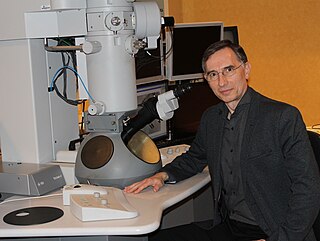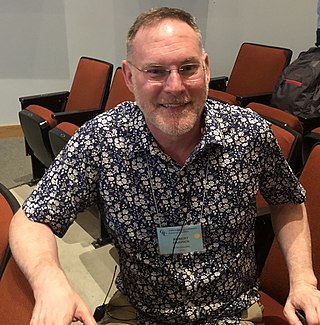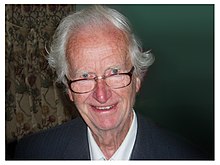
The Niels Bohr Institute is a research institute of the University of Copenhagen. The research of the institute spans astronomy, geophysics, nanotechnology, particle physics, quantum mechanics, and biophysics.
Martin David Kamen was an American chemist who, together with Sam Ruben, co-discovered the synthesis of the isotope carbon-14 on February 27, 1940, at the University of California Radiation Laboratory, Berkeley. He also confirmed that all of the oxygen released in photosynthesis comes from water, not carbon dioxide, in 1941.
Bismuth (83Bi) has 41 known isotopes, ranging from 184Bi to 224Bi. Bismuth has no stable isotopes, but does have one very long-lived isotope; thus, the standard atomic weight can be given as 208.98040(1). Although bismuth-209 is now known to be radioactive, it has classically been considered to be a stable isotope because it has a half-life of approximately 2.01×1019 years, which is more than a billion times the age of the universe. Besides 209Bi, the most stable bismuth radioisotopes are 210mBi with a half-life of 3.04 million years, 208Bi with a half-life of 368,000 years and 207Bi, with a half-life of 32.9 years, none of which occurs in nature. All other isotopes have half-lives under 1 year, most under a day. Of naturally occurring radioisotopes, the most stable is radiogenic 210Bi with a half-life of 5.012 days. 210mBi is unusual for being a nuclear isomer with a half-life multiple orders of magnitude longer than that of the ground state.
Naturally occurring chromium (24Cr) is composed of four stable isotopes; 50Cr, 52Cr, 53Cr, and 54Cr with 52Cr being the most abundant (83.789% natural abundance). 50Cr is suspected of decaying by β+β+ to 50Ti with a half-life of (more than) 1.8×1017 years. Twenty-two radioisotopes, all of which are entirely synthetic, have been characterized, the most stable being 51Cr with a half-life of 27.7 days. All of the remaining radioactive isotopes have half-lives that are less than 24 hours and the majority of these have half-lives that are less than 1 minute. This element also has two meta states, 45mCr, the more stable one, and 59mCr, the least stable isotope or isomer.
Potassium has 26 known isotopes from 31
K to 57
K, with the exception of still-unknown 32
K, as well as an unconfirmed report of 59
K. Three of those isotopes occur naturally: the two stable forms 39
K (93.3%) and 41
K (6.7%), and a very long-lived radioisotope 40
K (0.012%)

Robert Vance Gentry was an American young Earth creationist and nuclear physicist, known for his claims that radiohalos provide evidence for a young age of the Earth.
Richard Alan Andersen is an American neuroscientist. He is the James G. Boswell Professor of Neuroscience at the California Institute of Technology in Pasadena, California. His research focuses on visual physiology with an emphasis on translational research to humans in the field of neuroprosthetics, brain-computer interfaces, and cortical repair.

The Ghana Atomic Energy Commission (GAEC) is the state organization in Ghana involved with surveillance of the use of nuclear energy in Ghana. It is similar in aim to the Ghana Nuclear Society (GNS), with the difference being that the GNS is a nonprofit organisation, whereas the GAEC is part of the parliament of Ghana. Its primary objectives were set out by the parliament act 588, which involve investigating the use of nuclear energy for Ghana and supporting research and development both in Ghana and abroad.

David Jay Julius is an American physiologist and Nobel Prize laureate known for his work on molecular mechanisms of pain sensation and heat, including the characterization of the TRPV1 and TRPM8 receptors that detect capsaicin, menthol, and temperature. He is a professor at the University of California, San Francisco.
Spin squeezing is a quantum process that decreases the variance of one of the angular momentum components in an ensemble of particles with a spin. The quantum states obtained are called spin squeezed states. Such states have been proposed for quantum metrology, to allow a better precision for estimating a rotation angle than classical interferometers.

Patrick Cordier is a mineralogist who uses experimental and numerical approaches to study the plasticity of geological materials. He has authored or co-authored over 200 articles in international scientific journals. He received the Dana Medal from the Mineralogical Society of America in 2016, and is currently a chief editor of the European Journal of Mineralogy. and a member ofInstitut Universitaire de France.

Tamir Gonen is an American structural biochemist and membrane biophysicist best known for his contributions to structural biology of membrane proteins, membrane biochemistry and electron cryo-microscopy (cryoEM) particularly in electron crystallography of 2D crystals and for the development of 3D electron crystallography from microscopic crystals known as MicroED. Gonen is an Investigator of the Howard Hughes Medical Institute, a professor at the University of California, Los Angeles, the founding director of the MicroED Imaging Center at UCLA and a Member of the Royal Society of New Zealand.

Kiyoshi Nagai was a Japanese structural biologist at the MRC Laboratory of Molecular Biology Cambridge, UK. He was known for his work on the mechanism of RNA splicing and structures of the spliceosome.

Yi Zhang is a Chinese-American biochemist who specializes in the fields of epigenetics, chromatin, and developmental reprogramming. He is a Fred Rosen Professor of Pediatrics and professor of genetics at Harvard Medical School, a senior investigator of Program in Cellular and Molecular Medicine at Boston Children's Hospital, and an investigator of the Howard Hughes Medical Institute. He is also an associate member of the Harvard Stem Cell Institute, as well as the Broad Institute of MIT and Harvard. He is best known for his discovery of several classes of epigenetic enzymes and the identification of epigenetic barriers of SCNT cloning.
Jeffrey R. Long is a professor of chemistry at University of California, Berkeley known for his work in metal−organic frameworks and molecular magnetism. He was elected to the American Academy of Arts and Sciences in 2019 and is the 2019 F. Albert Cotton Award recipient. His research interests include: synthesis of inorganic clusters and porous materials, investigating the electronic and magnetic properties of inorganic materials; metal-organic frameworks, and gas storage/capture.

Max Born was a widely influential German physicist and mathematician who was awarded the 1954 Nobel Prize in Physics for his pivotal role in the development of quantum mechanics. Born won the prize primarily for his contributions to the statistical interpretation of the wave function, though he is known for his work in several areas of quantum mechanics as well as solid-state physics, optics, and special relativity. Born's entry in the Biographical Memoirs of Fellows of the Royal Society included thirty books and 330 papers.
Quantum engineering is the development of technology that capitalizes on the laws of quantum mechanics. Quantum engineering uses quantum mechanics as a toolbox for the development of quantum technologies, such as quantum sensors or quantum computers.

Robert William Carpick is a Canadian mechanical engineer. He is currently director of diversity, equity, and inclusion and John Henry Towne Professor in the Department of Mechanical Engineering and Applied Mechanics at the University of Pennsylvania. He is best known for his work in tribology, particularly nanotribology.
Edward H. Sargent is a Canadian scientist, who serves as University Professor of Electrical & Computer Engineering and Vice-President of Research and Innovation, and Strategic Initiatives at the University of Toronto. He also is the Canada Research Chair in Nanotechnology. He will join the Departments of Chemistry and of Electrical and Computer Engineering at Northwestern University, and will be affiliated with the International Institute for Nanotechnology at Northwestern.
John Michael Jumper is an American senior research scientist at DeepMind Technologies. Jumper and his colleagues created AlphaFold, an artificial intelligence (AI) model to predict protein structures from their amino acid sequence with high accuracy. Jumper has stated that the AlphaFold team plans to release 100 million protein structures. The scientific journal Nature included Jumper as one of the ten "people who mattered" in science in their annual listing of Nature's 10 in 2021.










